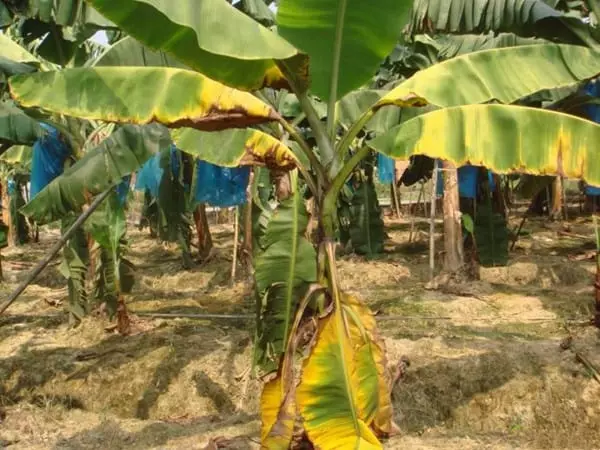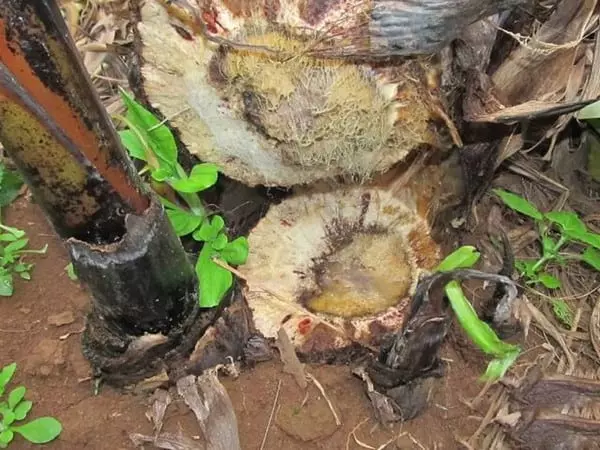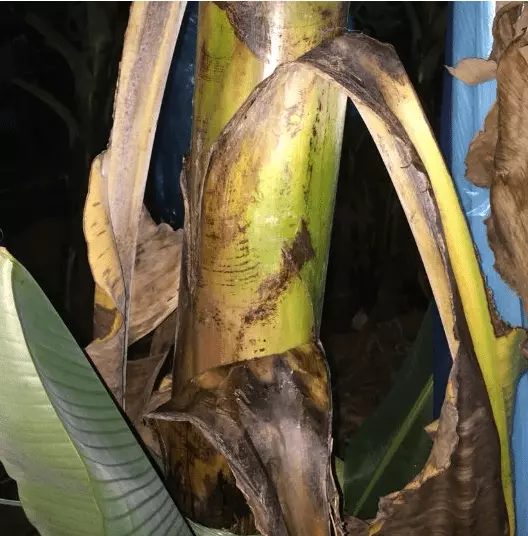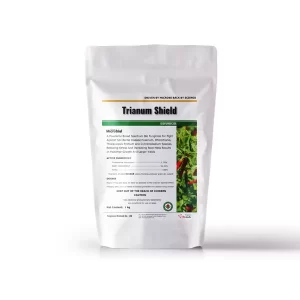Fusarium wilt of Banana, also called panama wilt tropical race 4 (TR4) disease, is a severe disease of the world’s most popular fruit. The banana panama disease is caused by the fungus Fusarium oxysporum f. sp. cubense, has destroyed crops and cost farmers billions of dollars in losses.
The fungus that causes the disease, Fusarium oxysporum f. sp. cubense, can infect all varieties of cultivated bananas (Musa spp.), including both Cavendish bananas and plantain types. The pathogen is spread in contaminated soil or water and enters through the roots.
Once inside plant, the fungus clogs the xylem vessels, preventing water and nutrients from flowing up to the leaves. This results in wilting and yellowing of banana tree leaves, starting with those closest to the ground and progressing up the plant. In infected banana plants, large sections of the pseudostem may collapse, eventually leading to death.
There are currently no known treatments for wilted bananas once parts of them is infected. The most effective way to stop disease transmission is to remove any infected plants immediately.

The fungus infects plant through the roots and spreads upward through xylem vessels, causing them to become clogged. Thisreduces water and nutrient uptake by the plant, which eventually leads to wilting and death.
Fusarium wilt can be difficult to control once it has infected a banana plantation. The best way to prevent the disease is to avoid planting bananas in areas where the fungus is known to occur. If you suspect your bananas have panama wilt, remove them from the soil quickly to prevent the disease from spreading.

The pathogen fungus fusarium oxysporum tr4 attacks plant vascular system, causing it to wilt and die. The disease has been a serious problem in banana industry in many countries around the world.
There are three main ways that fungus can spread:
1) Soil movement: The fungus can survive in the soil for many years, and is often transported on farm machinery or in polluted soil.
2) Water: The fungus can also spread through water, particularly during floods.
3) Planting material: Infected plant material (such as cuttings or transplants) can also spread the disease.
Once the panama disease has infected a plant, it can be difficult to treat. The best way to prevent it is to avoid introducing fungus into new areas. This means using clean planting material and following good agricultural practices such as crop rotation.

Organic micro-based solutions are effective against the banana diseases because they contain natural bacteria and fungi that help control disease. These microorganisms are beneficial to plant because they help break down organic matter and release nutrients into soil. This process is known as biodegradation.
When applied to the affected area, these spores will colonize root zone and make a symbiotic link with the plant. They help protect the plant from disease and pests, while plant will provide them with food and shelter.
There are several different products available that contain these beneficial microorganisms. Some of them are specific to the disease, while others can be used for general disease control or pest control.
Disease management of panama wilt of banana can be complex. The best way to control the disease is to prevent it from occurring in the first place. This can be achieved by growing resistant cultivar and leaving the plant’s area clean and free of rubble.
If the disease does occur infested soil, it is essential to remove affected plants as soon as possible to prevent its spread. Fusarium oxysporum fungicide can help control the disease, but you must be careful when using chemical fungicide to avoid harming plants, and it causes pollution of dirt, water, and air and affects human health. The identification of natural enemies of Fusarium oxysporum f. sp. cubense is a viable alternative to designing crop protection plans.

The better treatment would be to use organic fungicide, trichoderma spp. produce metabolites such as peptabiols, polyketides, and terpenes with antifungal activity which restrict the growth of surrounding fungi. This allows Trichoderma to consume free nutrients and spread in the rhizosphere.
Besides, Mycoparasitism might require direct antifungal activity. Likewise, Trichoderma can directly uptake and utilize nutrients from other fungi. Moreover, Trichoderma is a fungus that recognizes other fungi, leading to attachment and formation of appressoria-like structures. These structures exert physical force on the host.
Trianum Shield is trichoderma fungicide, active ingredient trichoderma harzianum. After apply, it will colonize at rhizosphere of banana plants, create a biofilm around banana roots to inhibit plant pathogens and induce defence response. This protection extends to both local and systemic tissues. The growth promotion of Trichoderma is beneficial to banana plant. This is because Trichoderma produces phytohormones and increases supply of iron to the plant.
Cutworms in gardens are a major menace to all..
As a farmer,I inspect my fields daily to monitor..
It all started with a worried farmer named Mr...

Leave a Reply